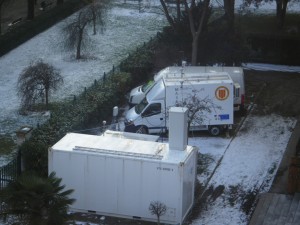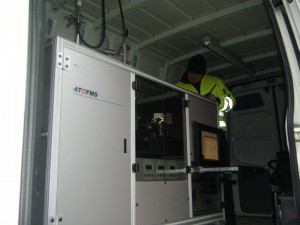Aerosol particles are in the air all around us. In fact, you will inhale 5 to 20 million particles in your next breath.
Dr. Robert Healy, a Marie-Curie Research Fellow at the University of Toronto, delivered SOCAAR’s inaugural seminar on October 3rd. He discussed how an Aerosol Time-of-Flight Mass Spectrometer (ATOFMS) can be used to answer two important questions about aerosol particles: Where do these particles come from? What is their chemical composition?
Healy used the ATOFMS to study the air quality in two urban environments: Cork City, Ireland and Paris, France.
A van containing the ATOFMS instrument was setup by the harbour in Cork City to assess local air quality. The ATOFMS allows for real-time chemical analysis meaning that sources of particle emissions could be tracked. “Emissions coming from nearby shipping docks were compared to the shipping logs, matching up to particular ships,” says Healy.
The ATOFMS identified a unique particle type from local ship exhaust containing soot, vanadium, iron and sulfate. Other particles from traffic and home heating were also identified by the ATOFMS. Analysis of the particulate matter revealed that air quality in Cork City is affected almost exclusively by local human-made sources like home heating, traffic, and ship exhaust— rather than natural sources like sea salt.
A similar setup was used in Paris to look at the impact of the urban plume on the surrounding regions. The ATOFMS instrument showed the major sources of particulate matter came from traffic and domestic wood combustion. However, at times the majority of these particles were from sources outside of France—not locally emitted— suggesting instances of poor air quality in Pairs are not necessarily from local emissions.

 ATOMFS sampling in Paris, France Ian O’Connor working with the ATOFMS
ATOMFS sampling in Paris, France Ian O’Connor working with the ATOFMS
These two case studies demonstrate that single particle mass spectrometry is useful for identifying sources of particulate matter in diverse environments.
“The ATOFMS results are useful for informing air quality mitigation strategies,” says Healy. “The technique enables the association of unique particles with specific sources.”
